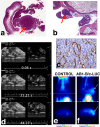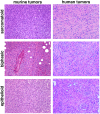Human malignant mesothelioma is recapitulated in immunocompetent BALB/c mice injected with murine AB cells
- PMID: 26961782
- PMCID: PMC4785401
- DOI: 10.1038/srep22850
Human malignant mesothelioma is recapitulated in immunocompetent BALB/c mice injected with murine AB cells
Abstract
Malignant Mesothelioma is a highly aggressive cancer, which is difficult to diagnose and treat. Here we describe the molecular, cellular and morphological characterization of a syngeneic system consisting of murine AB1, AB12 and AB22 mesothelioma cells injected in immunocompetent BALB/c mice, which allows the study of the interplay of tumor cells with the immune system. Murine mesothelioma cells, like human ones, respond to exogenous High Mobility Group Box 1 protein, a Damage-Associated Molecular Pattern that acts as a chemoattractant for leukocytes and as a proinflammatory mediator. The tumors derived from AB cells are morphologically and histologically similar to human MM tumors, and respond to treatments used for MM patients. Our system largely recapitulates human mesothelioma, and we advocate its use for the study of MM development and treatment.
Figures










References
-
- Husain A. N. et al. Guidelines for pathologic diagnosis of malignant mesothelioma: 2012 update of the consensus statement from the International Mesothelioma Interest Group. Arch Pathol Lab Med. 137, 647–667 (2013). - PubMed
-
- Davidson B. Prognostic factors in malignant pleural mesothelioma. Hum Pathol. 46, 789–804 (2015). - PubMed
Publication types
MeSH terms
Substances
LinkOut - more resources
Full Text Sources
Other Literature Sources
Medical

